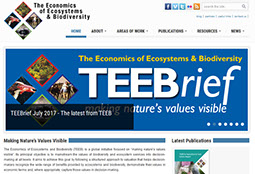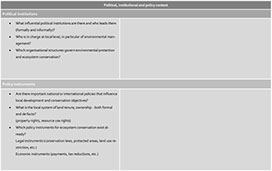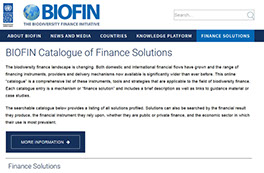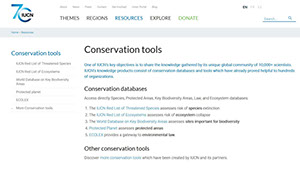Useful links

The Economics of Ecosystems and Biodiversity (TEEB) is a global initiative focused on “making nature’s values visible”. Its principal objective is to mainstream the values of biodiversity and ecosystem services into decision-making at all levels.

ValuES – Integrating Ecosystem Services into Policy, Planning and Practice is a global project that aids decision-makers in our partner countries in recognizing and integrating ecosystem services into policy making, planning and implementation of specific projects.

The Biodiversity Finance Initiative (BIOFIN) aims to deliver a new methodological framework, facilitating the identification, development and implementation of optimal and evidence-based finance plans and solutions. It has developed an online “catalogue” with a comprehensive list of instruments, tools and strategies that are applicable to the field of biodiversity finance.

The Landscape Investment and Finance Tool (LIFT) comprises of a set of modules that help landscape initiatives define, develop and find finance for their landscape priorities.

The International Union for Conservation of Nature (IUCN) conservation tools platform offers conservation databases and tools.
References
Anyaegbunam, C., Mefalopulos, P. & Moetsabi, T. (2004): Participatory Rural Communication Appraisal. A Handbook. Second Edition. SADC Centre of Communication for Development Harare and Food and Agriculture Organization of the United Nations, Rome. URL: ftp://ftp.fao.org/docrep/fao/008/y5793e/y5793e00.pdf
Aravamuthan, M., Ruete, M., Dominguez, C. (2015): Credit Enhancement for Green Projects Promoting credit-enhanced financing from multilateral development banks for green infrastructure financing. International Institute for Sustainable Development (IISD), Winnipeg. URL: https://www.iisd.org/sites/default/files/publications/credit-enhancement-green-projects.pdf (accessed July 2018)
Ash, N., Blanco, H., Brown, C., Garcia, K., Henrichs, T., Lucas, N., Raudsepp-Hearne, C., Simpson, R.D., Scholes, R., Tomich, T.P., Vira, B. & Zurek, M. (eds.) (2010): Ecosystems and Human Well-being: A Manual for Assessment Practitioners, Washington, D.C. URL: http://www.unep-wcmc.org/resources-and-data/ecosystems-and-human-wellbeing--a-manual-for-assessment-practitioners
Asia Forest Network (2002): Participatory Rural Appraisal for Community Forest Management. Tools and Techniques, Santa Barbara. URL: http://www.myfirecommunity.net/discussionimages/NPost8219Attach1.pdf
BBOP – Business and Biodiversity Offsets Programme (2012): BBOP Standard on Biodiversity Offsets and associated material, Washington, D.C. URL: http://bbop.forest-trends.org/pages/guidelines
BBOP – Business and Biodiversity Offsets Programme (2012): Glossary. BBOP, Washington, D.C. URL: http://bbop.forest-trends. org/guidelines/Updated_Glossary
BIOFIN (2018): Catalogue of Finance Solutions. URL: http://biodiversityfinance.net/finance-solutions (accessed July 2018)
Brown, J. & Bird, N. (2011): Sustainable natural resource management in Namibia: Successful community-based wildlife conservation. Overseas Development Institute, London. URL: http://www.odi.org/publications/5185-namibia-environmen- tal-management-wildlife-conservation-development-progress
CAPE (2009): Biodiversity Fiscal Incentives: A Framework on Fiscal Incentives for Biodiversity. Cape Action for People and the Environment, Claremont. URL: https://www.cbd.int/doc/meetings/im/wscbteeb-mena-01/other/wscbteeb-mena-01-biodi- v&fiscal-incentives-en.pdf
Centre for Social Responsibility in Mining (2014): Mongolia’s mining boom raises environment concerns, The University of Queensland, Australia. URL: https://www.csrm.uq.edu.au/news/http-www-dw-de-mongolias-mining-boom-raises-envi- ronment-concerns-a-17534285
CFA – Conservation Finance Alliance (2008): Business Planning for Protected Areas, Gland. URL: http://conservationfinance.org/guide/guide/
Chambers, W. B. & Toth, F. L. (2005): Typology of Responses (Chapter 2). In: Chopra, K. et. al. (Ed.): Ecosystems and hu-man well-being, Vol. 3: Policy Responses, Findings of the Responses Working Group (Millennium Ecosystem Assessment Series), Chicago. URL: http://www.maweb.org/documents/document.307.aspx.pdf
CICES – The Common International Classification of Ecosystem Services (2015): Towards a common classification of ecosystem services. URL: http://cices.eu/
Clements, T., John, A., Nielsen, K., An, D., Tan, S. & Milner-Gulland, E.J. (2010): Payments for biodiversity conservation in the con-text of weak institutions: comparison of three programs from Cambodia, Ecological Economics, 69: 1283–1291
CMP – Conservation Measures Partnership (2015): The Open Standards for the Practice of Conservation. URL: http://cmp-open- standards.org/
Community Tool Box (2014): Section 8. Identifying and Analyzing Stakeholders and Their Interests, Work Group for Community Health and Development at the University of Kansas. URL: http://ctb.ku.edu/en/table-of-contents/participation/encouraging-involvement/identify-stakeholders/main
Conservation International (2014): Verde Ventures. Investing in sustainable businesses. URL: http://www.conservation.org/pro- jects/Pages/Verde-Ventures.aspx
Cordato, R.E. (2010): The Polluter Pays Principle: A Proper Guide for Environmental Policy, Institute for Research on the Eco-nomics of Taxation Studies in Social Cost, Regulation, and the Environment: No. 6, Washington. URL: http://iret.org/pub/SCRE-6.PDF
CPIC and PwC (2018), CONSERVATION INVESTMENT BLUEPRINTS: A Development Guide, http://cpicfinance.com/wp-content/uploads/2018/01/CPIC_Blueprint_Development_Guide_2018.pdf (accessed August 2018)
Dreschler, M. & Wätzold, F. (2007): Applying tradable permits to biodiversity conservation: Effects of space-dependent conservation benefits and cost heterogeneity on habitat allocation, Ecological Economics, 68: 1083-1092. URL: http://www. sciencedirect.com/science/article/pii/S092180090800342X
Dudley, N. & Stolton, S. (2009): The Protected Areas Benefits Assessment Tool. A methodology, WWF – World Wide Fund for Nature, Gland. URL: http://wwf.panda.org/?174401/PABAT
Dudley, N. (2015): Guidelines for Applying Protected Area Management Categories. IUCN, Gland. URL: https://www.iucn.org/sites/dev/files/import/downloads/iucn_assignment_1.pdf (accessed July 2018)
Eco-Label Index (2014): Glossary. URL: http://www.ecolabelindex.com/glossary/#E
Emerton, L. & Bos, E. (2004): Value. Counting Ecosystems as an Economic Part of Water Infrastructure. Gland and Cam-bridge: IUCN. URL: http://cmsdata.iucn.org/downloads/value_en.pdf
Emerton, L. & Nlom, J-H. (2011): Congo Basin Protected Area Systems: Environmental Economic Context. Yaoundé: WWF Central Africa Regional Programme Office
Emerton, L. (1998): Using Economics for Biodiversity Strategies and Action Plans in Eastern Africa. Nairobi: IUCN Eastern Africa Regional Office. URL: http://data.iucn.org/dbtw-wpd/edocs/1998-071.pdf
Emerton, L. (2008): Opportunities to improve sustainable PA financing mechanisms and encourage sustainable livelihoods in the Lower Volga. UNDP/GEF Project “Conservation of Wetland Biodiversity in the Lower Volga”, Volgograd
Emerton, L. (2010a): Environmental financing mechanisms for watershed management solutions in Cambodia, Lao PDR and Viet Nam. MRC – GTZ Cooperation Programme Watershed Management Project (WSMP), GIZ and Mekong River Commission, Vientiane
Emerton, L. (2010b): Lower Amu Darya State Biosphere Reserve: Business Plan 2011–2015. GEF/UNDP PIMS 2109: Conservation of Tugai Forest and Strengthening Protected Areas System in the Amu Darya Delta of Karakalpakstan, Nukus
Emerton, L. (2012): Rethinking Economics, Markets and Incentives: using economic tools at the landscape level. Gland: IUCN. URL: http://data.iucn.org/dbtw-wpd/edocs/2012-023.pdf
Emerton, L., Phạm Xuân Phương & Hà Thị Mừng (2011): PA financing mechanisms in Viet Nam: lessons learned and future directions. Report prepared for GIZ/MARD Project “Conservation of Biodiversity in Forest Ecosystems in Vietnam”, Hanoi
Equator Initiative (2015): Equator Initiative Case Study Database. URL: http://equatorinitiative.org/index.php?option=com_ winners&view=casestudysearch&Itemid=685&lang=en (last access: 07/21/2015)
Erdmann, M.V., Merrill, P.R., Arsyad, I. & Mongdong, M. (2003): Developing a diversified portfolio of sustainable financing options for Bunaken National Marine Park. Paper presented at the workshop Building a Complex Portfolio to Sustainably Finance Marine Protected Area Networks, Vth World Parks Congress: Sustainable Finance Stream, Durban. URL: http://conser- vation-finance.org/guide/WPC/WPC_documents/Apps_01_Erdmann_v1.pdf
FAO - EAF-Net (2011): EAF Planning and Implementation Tools. Stakeholder Workshops. In: EAF-Net (2011): EAF Toolbox, EAF Planning and Tool selection, Consultation tools, Rome. URL: http://www.fao.org/fishery/eaf-net/eaftool/eaf_tool_3
FAO (2002): Land Tenure and Rural Development. FAO Land Tenure Studies 3, Rome. URL: http://www.fao.org/docrep/005/ y4307e/y4307e09.htm
Ferraro, P.J. & Kiss, A. (2002): Direct Payments to Conserve Biodiversity. Science Compass, Policy Forum: Ecology, 298: 1718–1719. URL: http://www.ecnc.org/uploads/documents/direct-payments-to-conserve-biodiversity.pdf
Forest Trends, Katoomba Group & UNEP (2008): Payments for Ecosystem Services: Getting Started. A Prime, Nairobi. URL: http:// www.unep.org/pdf/PaymentsForEcosystemServices_en.pdf
Frogleaps (2013): Tool: Understanding your target audiences. URL: http://www.frogleaps.org/tools/Tool_Understanding_target_audiences.pdf (accessed December 2017)
Giuliani, A., Abdulkarim, N. & Buer, M. (2006): Linking Biodiversity Products to Markets to improve the Livelihoods of the Resource Poor: Case Study on the Market Chain of Capers in Syria, Proceedings of the Regional Consultation on Linking Producers to Markets: Lessons Learned and Successful Practices, Cairo. URL: http://www.researchgate.net/publication/228477721_Link- ing_biodiversity_products_to_markets_to_improve_the_livelihoods_of_the_resource_poor_Case_study_on_the_mar- ket_chain_of_capers_in_Syria
GIZ, UFZ & CSF (2014): ValuES – Methods for integrating ecosystem services into policy, planning, and practice. URL: http:// aboutvalues.net/
Gole, C., Burton, M., Williams, K. J., Clayton, H., Faith, D. P., White, B., Huggett, A. & Margules, C. (2005): Auction for Landscape Recovery Final Report. WWF, Sydney. URL: http://awsassets.wwf.org.au/downloads/wa013_auction_for_landscape_recov- ery_1oct05.pdf
Hanley, N., Banerjee, S., Lennox, G.D. & Armsworth, P.R. (2012): How should we incentivize private land-owners to ‘produce’ more biodiversity? Oxford Review of Economic Policy, 28(1): 93–113. URL: http://oxrep.oxfordjournals.org/content/28/1/93.full
Harvey, B., Ensor, J., Garside, B., Woodend, J., Naess, L. O., Carlile, L. (2013): Social learning in practice: A review of lessons, impacts and tools for climate change adaptation. CGIAR Research Program on Climate Change, Agriculture and Food Security (CCAFS), Copenhagen. URL: https://cgspace.cgiar.org/rest/bitstreams/22997/retrieve (accessed July 2018)
Hawkins, S. (2011): Laying the Foundation: An Analytical Tool for Assessing Legal and Institutional Readiness for PES. URL: http://www.forest-trends.org/documents/files/doc_3014.pdf
Hesselink, F., Goldstein, W., van Kempen, P.P., Garnett, T. & Dela, J. (2007): Communication, Education and Public Awareness (CEPA). A Toolkit for National Focal Points and NBSAP Coordinators. Montreal: Convention on Biological Diversity and IUCN. URL: http://www.frogleaps.org/downloads/cepa_toolkit_english.pdf
http://www.sciencedirect.com/science/article/pii/S0921800909004595
https://www.conservationgateway.org/Documents/Cap%20Handbook_June2007.pdf
Huxham, M., Kairo, J., Skov, M., Hillams, T., Nunan, F. & Mencuccini, M. (2012): Marketing the mangroves: can carbon payments make conservation work? Paper presented at Meeting on mangrove Ecology, Functioning and Management, Galle
Iftikhar, U. (2004): Personal Communication; Khan, S.R., & Parvaiz, A.N. (2001): National Case Study on the Integration of Economics into Pakistan’s Biodiversity Action Plan. IUCN – The World Conservation Union, Pakistan Country Programme: Karachi. URL: http://www.eldis.org/go/home&id=70184&type=Document#.VajUZWMTV4M
Kettunen, M. & ten Brink, P. (eds.) (2013): Social and Economic Benefits of Protected Areas: An Assessment Guide, Routledge.
Kosmus, M., Renner, I. & Ullrich, S. (2012): Integrating Ecosystem Services into Development Planning – a stepwise approach for practitioners based on the TEEB approach. Gesellschaft für Internationale Zusammenarbeit (GIZ), Eschborn. URL: http:// www.aboutvalues.net/data/six_steps/giz_2012_en_integr_ecosys_serv_in_dev_planning.pdf
Kram, M., Bedford, C., Durnin, M., Luo, Y., Rokplelnis, K., Roth, B., Smith, N., Wang., Y., Yu, G., Yu, Q. & Zhao, X. (2012): Protecting China’s Biodiversity – A Guide to Land Use, Land Tenure, and Land Protection Tools, The Nature Con-servancy (TNC), Beijing. URL: http://www.nature.org/media/china/chinabook-wholebook-lowres.pdf
Kuusela, O.-P., Amacher, G. S. (2016): A Review of Performance Bonding in Forest Policy Settings. Oregon. URL: https://link.springer.com/content/pdf/10.1007%2Fs40725-016-0043-y.pdf (accessed July 2018)
Landell-Mills, N. & Porras, I.T. (2002): Silver bullet or fools’ gold? A global review of markets for forest environmental services and their impact on the poor. International Institute for Environment and Development (IIED), London. URL: https://www.cbd. int/doc/external/iied/iied-silver-report-2002-en.pdf
Latham, J.E., Trivedi, M., Amin, R., D’Arcy, L. (2014): A Sourcebook of Biodiversity Monitoring for REDD+. Zoological Society of London, London. URL: https://www.zsl.org/sites/default/files/media/2014-10/ZSL_GIZ_REDD_Sourcebook_2014_0.pdf (accessed December 2017)
Le Quesne, T. & McNally, R. (2005): The Green Buck: Using economic tools to deliver conservation goals: a WWF field guide. The WWF Sustainable Economics Network, World Wide Fund for Nature UK, Godalming. URL: https://www.cbd.int/financial/doc/ several-several-wwf.pdf
Loft, L., Gebara, M. F., Wong, G. Y. (2016): The experience of ecological fiscal transfers: Lessons for REDD+ benefit sharing. CIFOR, Bogor. URL: http://www.cifor.org/publications/pdf_files/OccPapers/OP-154.pdf (accessed July 2018)
MA – Millennium Ecosystem Assessment (2005): Ecosystems and Human Well-being: Current State and Trends, Volume 1, Washington, D.C. URL: http://www.millenniumassessment.org/en/Global.html
Malaysian Green Technology Corporation (2012): Green Technology Financing Scheme (GTFS). URL: https://www.gtfs.my/
May. P., Veiga Neto, F., Denardin, V. & Loureiro, W. (2002): Using Fiscal Instruments to Encourage Conservation: Municipal Responses to the ‘Ecological’ Value-added Tax in Paraná and Minais Gerais, Brazil. In: Pagiola, S., Bishop, J. & Landell-Mills, N. (eds): Selling Forest Environmental Services: Market-Based Mechanisms for Conservation and Development, London. URL: http://www.ecosystemmarketplace.com/pages/dynamic/resources.library.page.php?page_id=794§ion=water_mar- ket&eod=1
MCE Social Capital (2012): Philanthropic Guarantee Agreement. San Francisco. URL: http://www.mcesocap.org/wp-content/uploads/2014/08/MCE-PGA-July-2012-Edition.pdf (accessed December 2017)
Morrison, A. & Aubrey, W. (2010): Payments for Ecosystem Services Literature Review: A review of lessons learned, and a frame- work for assessing PES feasibility, World Wildlife Fund for Nature (WWF). URL: http://www.planvivo.org/wp-content/up- loads/Framework-for-PES-feasibility_WWF_MorrisonAubrey_2010.pdf
MWHCB Inc. (2012): MaluaBioBank. URL: http://www.maluabiobank.com/index.html
Nabangchang, O., Seenprachawong, U., Janamporn, S., Suthat, K., Thongsopin, K. & Marchant, R. (2012): Sustainable Financing Strategy & Business Plan for Lanta, Similan and Surin Islands Marine National Parks. Report prepared for Strengthening Andaman Marine Protected Areas Network (SAMPAN) Project, International Union for Conserva-tion of Nature (IUCN) Thailand Programme, Bangkok.
Nelson, N. (2008): Making Wildlife Pay in Northern Tanzania, Ecosystem Marketplace. URL: http://www.ecosystemmarketplace. com/pages/dynamic/article.page.php?page_id=5934§ion=home&eod=1
Northern Rangeland Trust (2014): NRT State of Conservancies Report 2014, Kenya. URL: http://www.nrt-kenya.org/wp-content/ uploads/2015/06/SoC_Final_LowRes_SinglePages.pdf
OECD (2001): Measuring Capital – OECD Manual: Measurement of capital stocks, consumption of fixed capital and capital services. URL: http://www.oecd.org/std/na/1876369.pdf
OECD (2003): Harnessing Markets for Biodiversity. Towards Conservation and Sustainable Use. URL: http://portals.wi.wur.nl/ files/docs/File/nfp%20for%20all/FinancingMech/OECDHarnessingMarketsforBiodiversity.pdf
OECD (2005): Glossary of Statistical Terms. URL: http://stats.oecd.org/glossary/index.htm
OECD (2011): Environmental Taxation. A Guide for Policy Makers.URL: http://www.oecd.org/env/tools-evaluation/48164926.pdf
Office of Policy, Economics, and Innovation and Office of Water (2005): Applying lessons learned from wetlands mitiga-tion banking to water quality trading. U.S. Environmental Protection Agency, Washington, D.C. URL: http://www.eli.org/sites/ default/files/docs/lansiemstedshab05.pdf
Oli, K.P., Dasgupta, J., Dhakal, T.D. & Kollmair, M. (2007): Glossary of Access and Benefit Sharing Terms. ICIMOD, Kathmandu. URL: http://www.icimod.org/?q=2242
Pedro, A. F. P., Stump, D. (2012): Environmental licensing in 'Getting to Green'. World Bank, Washington D.C. URL: http://siteresources.worldbank.org/INTRANETENVIRONMENT/Resources/2443511279901011064/EnvironmentalLicensing.pdf (accessed July 2018)
Plan Vivo Foundation (2012): Plan Vivo Guidance Manual 2.0 for designing and implementing payments for ecosystem service programmes with rural communities. The Waterloo Foundation, Edinburgh. URL: http://www.planvivo.org/docs/Plan-Vivo-Guidance-Manual.pdf
Pollard, E.H.B., Win Hlaing, S. & Pilgrim, J.D. (2014): Review of the Taninthayi Nature Reserve Project as a conservation model in Myanmar. The Biodiversity Consultancy, Cambridge. URL: http://www.thebiodiversityconsultancy.com/wp-content/up- loads/2014/11/TNRP-review_TBC-20141.pdf
Rainforest Alliance (2012): Avoided Deforestation in the Coffee Forest in El Salvador, El Salvador. URL: http://www.rainforest-al- liance.org/climate/validation-verification/projects/banco-desarrollo-avoided-deforestation
REMA & PEI (2010): A Review of Existing and Potential Environmental Fiscal Reforms and other Economic Instruments in Rwanda. UNDP-UNEP Poverty-Environment Initiative, Kigali. URL: http://www.unpei.org/sites/default/files/e_library_docu- ments/A_REVIEW_OF_EXISTING_%20AND_POTENTIAL_%20ENVIRONMENTAL_%20FISCAL_%20REFORMS_%20AND_%20 OTHER_%20ECONOMIC_%20INSTRUMENTS_%20IN%20RWANDA.pdf
Rosales, R.M.P. (2003): Developing Pro-poor Markets for Environmental Services in the Philippines. International Institute for Environment and Development (IIED), London. URL: https://www.cbd.int/financial/pes/philippines-pespoor.pdf
Shames, S., Scherr, S. (2015): Scaling Up Investment & Finance for Integrated Landscape Management: Challenges & Innovations. EcoAgriculture Partners, Washington D.C. URL: https://ecoagriculture.org/wp-content/uploads/2015/12/Finance-whitepaper-web.pdf (accessed July 2018)
Shames, S., Scherr, S., den Besten, J. W. (2017): Landscape Investment and Finance Tool (LIFT). Ecoagriculture Partners and IUCN NL, Washington D.C. URL: https://liftkit.info (accessed July 2018)
Sinca Noua Foundation & Stroming Ltd (2005): A Policy Field Guide to Sinca Noua and the Tagla Mountains: Building a New, Sus- tainable Economy. Report commissioned by WWF, Stroming Ltd, Nijmegen. URL: http://www.stroming.nl/pdf/sincanoua.pdf
Smith, S., Rowcroft, P., Everard, M., Couldrick, L., Reed, M., Rogers, H., Quick, T., Eves, C. & White, C. (2013): Payments for Ecosystem Services: A Best Practice Guide. Department for Environment, Food and Rural Affairs, London. URL: https://www.gov.uk/ government/uploads/system/uploads/attachment_data/file/200920/pb13932-pes-bestpractice-20130522.pdf
Soejarto, D., Gyllenhaal, C., Fong, H., Xuan, L., Hiep, N., Hung, N., Bich, T., Southavong, B., Sydara, K. & Pezzuto, J. (2004): The UIC ICBG (University of Illinois at Chicago International Cooperative Biodiversity Group) Memorandum of Agreement: A Model of Benefit-Sharing Arrangement in Natural Products Drug Discovery and Devel-opment. Journal of Natural Products, 67: 294-299. URL: https://www.cbd.int/financial/bensharing/several-icbd2004.pdf
Sovinc, A. (2005): Management of Protected Areas: Alternative Models. Project CAMP Slovenia, Seča. URL: http://www.docstoc. com/docs/24173783/MANAGEMENT-OF-PROTECTED-AREAS-Alternative-Models
Spergel, B. & Taïeb, P. (2008): Rapid Review of Conservation Trust Funds. Conservation Finance Alliance, Working Group on Environmental Funds, Washington D.C. URL: https://www.cbd.int/financial/trustfunds/g-rapidassess.pdf
Stolton, S., Redford, K. H.,Dudley, N. (2014): The Futures of Privately Protected Areas. IUCN, Gland. URL: https://portals.iucn.org/library/sites/library/files/documents/PATRS-001.pdf (accessed July 2018)
Stoneham, g., Chaudhri, V., Ha, A., Strappazzon, L. (2003): Auctions for conservation contracts: an empirical examination of Victoria's BushTender trial. Melbourne. URL: https://onlinelibrary.wiley.com/doi/full/10.1111/j.1467-8489.2003.t01-1-00224.x (accessed July 2018)
Tchiofo Lontsi, R. (2008): Potentialities for payment mechanisms for environmental services in the Congo Basin forests: the case of biodiversity conservation. Thesis presented for the degree of MSc student in Tropical and International Forestry, Faculty of Forest Science and Wood Ecology, Georg-August University, Goettingen. URL: http://agritrop.cirad.fr/550052/1/ document_550052.pdf
TEEB – The Economics of Ecosystems and Biodiversity (2010): The Economics of Ecosystems and Biodiversity for Local and Regional Policy Makers. London
TEEB – The Economics of Ecosystems and Biodiversity (2012a): The Economics of Ecosystems and Biodiversity in Local and Regional Policy and Management. Edited by Heidi Wittmer and Haripriya Gundimeda. London
TEEB – The Economics of Ecosystems and Biodiversity (2012b): The Economics of Ecosystems and Biodiversity in Business and Enterprise. Edited by Joshua Bishop. London
TEEBcase by Almack K., Chatreaux M. based on D’Agens et al. (2009): Community forestry for public health, Nepal (2010). URL: http://www.teebweb.org/wp-content/uploads/2013/01/Community-forestry-for-public-health-Nepal.pdf
TEEBcase by Almack, K. (2010): Restoring Ecosystem Services to Prevent Flood Damage In Napa River Basin. URL: http://www. teebweb.org/wp-content/uploads/2013/01/River-restoration-to-avoid-flood-damage-USA.pdf
TEEBcase by Hayashi, K. (2010): Forest environmental tax, Japan. URL: http://www.teebweb.org/wp-content/uploads/2013/01/ Forest-environmental-tax-Japan.pdf
TEEBcase by Hayashi, K., Nishimiya, H. (2010): PES for habitat restoration to reintroduce Oriental White Stork, Japan. URL: http:// www.teebweb.org/wp-content/uploads/2013/01/Reintroduction-of-Oriental-White-Stork-through-PES-for-habitat-resto- ration-Japan.pdf
TEEBcase by Mbak, E. (2010): Cidanau Watershed PES scheme, Indonesia. URL: http://www.teebweb.org/wp-content/up- loads/2013/01/Cidanau-Watershed-PES-scheme-Indonesia.pdf
TEEBcase by Morrison, A. (2010): Enhancing Carbon offsets for sustainable land use, Scolel Te, Mexico. URL: http://www.teeb- web.org/wp-content/uploads/2013/01/Carbon-offsets-for-sustainable-land-use-Scolel-Te-Mexico.pdf
TEEBcase by Nishimiya, H. (2010): Flooding rice paddies for migrating birds, Japan. URL: http://www.teebweb.org/wp-content/ uploads/2013/01/Flooding-rice-paddies-for-migrating-birds-Japan.pdf
TEEBcase by Redondo-Brenes, A., Welsh, K. (2010): Procuencas Project, Costa Rica. URL: http://www.teebweb.org/wp-content/ uploads/2013/01/Procuencas-Project-Costa-Rica.pdf
TEEBcase by Rodricks, S. mainly based on Department of Environment Climate Change and Water 2009 & Mamouney et al. 2009 (2010): Biodiversity banking and offset scheme of New South Wales (NSW), Australia. URL: http://img.teebweb.org/wp-con- tent/uploads/2013/01/Biodiversity-Banking-and-Offset-scheme-New-South-Wales-Australia.pdf
TEEBcase by Rodricks, S. mainly based on Snow Leopard Trust (2010): Insurance scheme to protect Snow Leopards. URL: http:// www.teebweb.org/wp-content/uploads/2013/01/Insurance-scheme-to-protect-Snow-Leopards.pdf
TEEBcase by van Beukering, P., Cesar, H. (2010): Recreational value of coral reefs, Hawaii. URL: http://www.teebweb.org/wp-con- tent/uploads/2013/01/Recreational-value-of-coral-reefs-Hawaii.pdf
ten Kate, K., Treweek, J. & Ekstrom, J. (2010a): The use of market-based instruments for biodiversity protection – The case of habitat banking. Technical Report for European Commission DG Environment, London. URL: http://www.ieep.eu/assets/472/ eftec_habitat_banking_technical_report.pdf
ten Kate, K., Treweek, J. & Ekstrom, J. (2010b): The use of market-based instruments for biodiversity protection – Habitat Bank- ing case studies. Technical Report for European Commission DG Environment, London. URL: http://ec.europa.eu/environment/enveco/pdf/eftec_habitat_case_study.pdf
The Convention on Biological Diversity (2001): Mobilizing Funding For Biodiversity Conservation: A User-Friendly Training Guide: Tourism User Fees. Montreal. URL: https://www.cbd.int/doc/nbsap/finance/Guide_Tourism_Nov2001.pdf (accessed July 2018)
The Latvian Country Tourism Association (2005): The Green Certificate. Latvian Environment Protection Fund. URL: http://eco. celotajs.lv/pn/index.php?module=ContentExpress&func=display&meid=6&ceid=11
The Natural Capital (2012): InVEST – Integrated Valuation of Ecosystem Services and Tradeoffs. URL: http://invest.ecoinformatics.org
The World Bank (1998): Guidelines for Monitoring and Evaluation for Biodiversity Projects. Global Environment Division. Washington, D.C. URL: http://siteresources.worldbank.org/INTBIODIVERSITY/214584-1110959186651/20611829/270310Guid- lines0for0monitoring.pdf
Tiraa, A. & Wilmott, I. (2001): The Takitumu Conservation Area: a community-owned ecotourism enterprise in the Cook Islands. Industry and Environment 243(4): 42–45. URL: https://www.sciencebase.gov/catalog/item/5057885de4b01ad7e0281497
TNC – The Nature Conservancy (2007): Conservation Action Planning Handbook. Developing Strategies, Taking Action and Measuring Success at Any Scale, Arlington
UNDP (2009): Handbook on Planning, Monitoring and Evaluating for Development Results: 2.2 Stakeholder engagement. URL: http://web.undp.org/evaluation/handbook/ch2-2.html
UNDP (2012): Multi-Stakeholder Decision-Making. A Guidebook for Establishing a Multi-Stakeholder Decision-Making Process to Support Green, Low-Emission and Climate-Resilient Development Strategies. United Nations Development Programme Bureau for Development Policy Environment and Energy Group, New York. URL: http://www.uncclearn.org/sites/www.unc- clearn.org/files/inventory/undp137_0.pdf
UNDP (2015): Debt for Nature Swaps. New York. URL: https://www.undp.org/content/sdfinance/en/home/solutions/debt-for-nature-swaps.html (accessed July 2018)
UNEP (2001): Funding Protected Areas in the Wider Caribbean: A Guide for Managers and Conservation Organizations. Unit- ed Nations Environment Programme and the Nature Conservancy, Arlington. URL: http://www.dcbd.nl/sites/www.dcbd.nl/ files/documents/Curtis%202001%20Funding%20Protected%20Areas%20in%20the%20Wider%20Caribbean.pdf
UNEP (2004): Economic Instruments in Biodiversity-Related Multilateral Environmental Agreements, Nairobi. URL: http://www.unep.ch/etb/publication/EconInst/ecoInstBioMea.pdf
UNEP (2008): Desalination Resource and Guidance Manual for Environmental Impact Assessments. United Nations Environment Programme, Regional Office for West Asia, Manama, and World Health Organization, Regional Office for the Eastern Mediterranean, Cairo. URL: http://www.unep.org/Themes/Freshwater/PDF/Resource&GuidanceManualforEIAs.pdf
UNEP (2009): Training Resource Manual: The Use of Economic Instruments for Environmental and Natural Resource Management (First Edition). United Nations Environment Programme, Geneva. URL: http://www.unep.ch/etb/publications/EI%20 manual%202009/Training%20Resource%20Manual.pdf
UNEP (2010): Guidance Manual for the Valuation of Regulating Services. United Nations Environment Programme, Nairobi. URL: http://www.unep.org/pdf/Guidance_Manual_for_the_Regulating_Services.pdf
van der Meer, J. (2012): Labeling and Certification in 'Getting to Green'. World Bank, Washington D.C. URL: http://siteresources.worldbank.org/INTRANETENVIRONMENT/Resources/244351279901011064/GuidanceNoteonLabellingandCertification.pdf (accessed July 2018)
Waite, R., Burke, L., Gray, E., van Beukering, P., Brander, L., McKenzie, E., Pendleton, L., Schuhmann, P. & Tompkins, E. (2014): Coastal Capital: Ecosystem Valuation for Decision Making in the Caribbean. World Resources Institute, Washington, D.C. URL: http://www.wri.org/coastal-capital
WBCSD (2011): Guide to Corporate Ecosystem Valuation. A framework for improving corporate decision-making, World Business Council for Sustainable Development, Conches-Geneva. URL: http://www.wbcsd.org/DocRoot/iv9e2wIURXHjP8in- 0RVN/WBCSD_Guide_CEV_April_2011.pdf
Winrock International (2011): Payment for Forest Environmental Services: A Case Study on Pilot Implementation in Lam Dong Province Vietnam from 2006 – 2010. Winrock International, Little Rock. URL: https://www.winrock.org/sites/default/files/ publica-tions/attachments/PaymentForForestEnvironmentalServicesARBCPCaseStudy.pdf
WRI – World Resources Institute (2008a): Ecosystem Services: A Guide for Decision Makers, Washington, D.C. URL: http://pdf.wri. org/ecosystem_services_guide_for_decisionmakers.pdf (accessed December 2017)
WRI – World Resources Institute (2008b): The Corporate Ecosystem Services Review: Guidelines for Identifying Busi-ness Risks and Opportunities Arising from Ecosystem Change, Washington, D.C. URL: http://pdf.wri.org/corporate_ecosystem_services_review.pdf
WWF – World Wildlife Fund (2000): Stakeholder collaboration – Building bridges for conservation, Washington, D.C. URL: www.panda.org/downloads/ecoregions/collaboration.pdf
WWF – World Wildlife Fund (2009): Guide to Conservation Finance. Washington, D.C. URL: http://awsassets.panda.org/down- loads/wwf_guide_to_conservation_finance.pdf
WWF – World Wildlife Fund (2013): Guide to Building REDD+ Strategies: A toolkit for REDD+ practitioners around the globe. WWF-FCI, Washington, D.C. URL: http://www.wwf.de/fileadmin/fm-wwf/Publikationen-PDF/WWF_Guide_to_Building_ REDD_Strategies – A_toolkit_for_REDD_practitioners_around_the_Globe.pdf
WWF – World Wildlife Fund (2015): Establishment of Wadi Wuraya Mountain Protect Area, Fujairah (2006–2009). URL: http://uae. panda.org/ews_wwf/achievements/wadi_wurayah/#sthash.nuARYgHY.dpuf
Young, M.D., Gunningham, N., Elix, J., Lambert, J., Howard, B., Grabosky, P. & McCrone, E. (1996): Reimbursing the future: an evaluation of motivational, voluntary, price-based, property-right, and regulatory incentives for the conservation of biodiversity. CSIRO Division of Wildlife and Ecology, the Australian Centre for Environmental Law, and Community Solutions Biodiversity Unit, Department of the Environment, Sport and Territories. URL: http://www.environment.gov.au/archive/bio- diversity/publications/series/paper9/chapter6.html
Imprint
Introduction
Step 1:
Getting
organized
Step 3:
Identifying
ecosystem service opportunities
Step 2:
Scoping the
context &
stakeholders
Step 4:
Selecting
policy
instruments
Step 6:
Designing
and agreeing
on the instrument
Step 5:
Sketching
out the
instrument
Step 7:
Planning
for
implementation
Datenschutz
Resources
EN
ES











